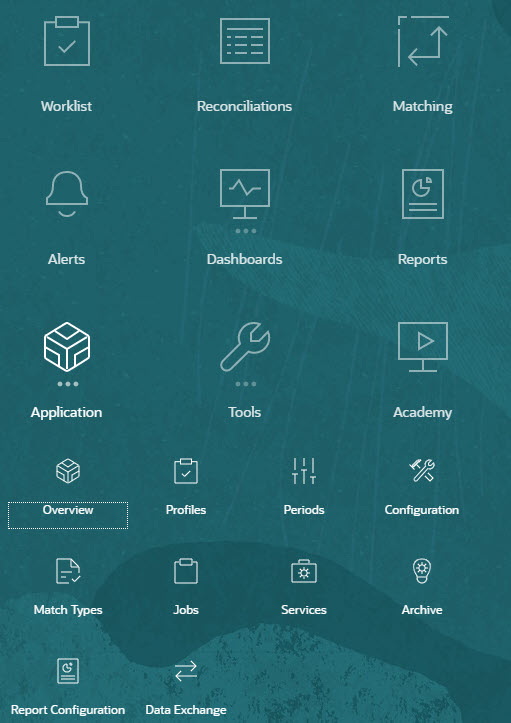Application
The Application card on Home links to the following:

- Overview displays recent reconciliation activity by different users, data loads (including links to the Dataload Execution dialog), and the number of change requests for today, last seven days, and all. See Reconciliation Activity.
- Profiles allows you to define profiles which are a building block for creating
reconciliations in Account Reconciliation.
See Defining Profiles.
- Periods allows you to work with periods to open, close, or lock. A Service Administrator can also work with periods from Application, then Configuration, and then Periods.
See Creating Periods.
- Configuration allows a Service Administrator to perform a variety of tasks to set up,
configure, and maintain Account Reconciliation:
- Attributes
- System Attributes
- Currencies
- Data Loads
- Filters
- Formats
- Lists
- Organizations
- Periods
- Settings
- Match Types allows you to create match types for Transaction Matching . See Creating Match Types.
-
Jobs displays the jobs performed in Reconciliation Compliance and Transaction Matching. The Summary in Minutes panel provides a summary of the user-created jobs that were run. See About Jobs in Account Reconciliation.
The Jobs for Reconciliation Compliance contains a Point of View (POV) as well as a search making it easier to display the jobs you want to see. See Viewing Jobs.
For Transaction Matching, Jobs displays the jobs performed in Transaction Matching, allows you to run various types of Transaction Matching jobs, and maintains a history of the jobs run. See Creating and Running Jobs
-
Services allows a Service Administrator to restart or run the following: email notifications, open reconciliations or system maintenance tasks such as synchronizing users.
Users with the Migrations - Administer application role can also run system maintenance.
See Services.
- Archive allows a Service Administrator to keep the size of the database in check and help
performance by using archive, restore, and purge functionality.
See Archiving.
- Report Configuration allows you to create custom reports, create report queries, and group reports.
- Data Exchange allows you to access the EPM Integration Agent functionality. Using the EPM Integration Agent, you can extract data from your on-premises data sources and then load the data directly to the Oracle Fusion Cloud Enterprise Performance Management.